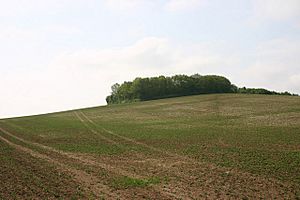Battle of Assandun facts for kids
Quick facts for kids Battle of Assandun |
|||||||
|---|---|---|---|---|---|---|---|
| Part of the Viking Invasions of England | |||||||
|
|||||||
| Belligerents | |||||||
| Kingdom of England | Kingdom of Denmark Jomsborg Vikings | ||||||
| Commanders and leaders | |||||||
| Edmund Ironside | Thorkell the Tall | ||||||
| Strength | |||||||
| More | thousands of Danish and Jomviking army | ||||||
| Casualties and losses | |||||||
| Heavier | Lighter | ||||||
The Battle of Assandun was a big fight between the Danish and English armies. It happened on October 18, 1016. Historians are not sure exactly where it took place. It might have been near Ashdon or Ashingdon in Essex, England. The battle ended with a victory for the Danes. Their leader was King Cnut. He defeated the English army led by King Edmund Ironside. This battle was the final step in the Danish takeover of England.
Contents
Why the Battle Happened
England's Kings and Cnut's Invasion
On April 23, 1016, King Æthelred the Unready of England died. He had been sick for a while. After his death, two different groups chose new kings. People in London chose Edmund to be king. But a larger group of important leaders, called the Witan, chose Cnut as king.
Cnut was a powerful Viking leader. He had already brought his army to England. In the autumn of 1016, King Edmund gathered his own army. These soldiers were from southern England. They marched to stop Cnut's Danish forces. Cnut's army had sailed across the River Thames into Essex.
The Battle of Assandun
A Fierce Fight in Essex
On October 18, the Danish army was heading back to their ships. That's when the English army found them. The two armies clashed at a place called Assandun. We still don't know the exact spot.
King Edmund was a brave warrior. He put his men into three lines. He fought right at the front to inspire his soldiers. King Cnut was more of a planner than a fighter. He directed his army from behind.
The Betrayal of Eadric Streona
The battle was very long and intense. It seemed like the Danes were fighting with incredible fury. They were determined to win or die trying. During the fight, a powerful English leader named Eadric Streona made a terrible choice. He was the ealdorman (a kind of regional governor) of Mercia. Eadric and his men left the battle. This allowed the Danish army to break through the English lines. This betrayal helped the Danes win a major victory.
Some stories say Eadric told his men to run away before the battle even started. He supposedly said they should escape or they would surely die. Even though many of his men left, King Edmund did not give up. He told his remaining warriors they were better off without the cowards. He then charged into the enemy, fighting bravely. Even though the English had more soldiers at first, they lost more men than the Danes.
Eadric Streona had actually switched sides before. He joined Cnut when Cnut first arrived in England. But after Cnut lost a battle at Otford, Eadric came back to the English side. However, this was a trick. He betrayed the English again at Assandun.
Losses on the Battlefield
During the battle, important people were killed. Eadnoth the Younger, who was a Bishop, was killed by Cnut's men. He was saying prayers for Edmund's soldiers at the time. Another important leader, the ealdorman Ulfcytel Snillingr, also died in the battle.
What Happened After the Battle
A Treaty and a New King
After his defeat, King Edmund had to make a deal with Cnut. They signed a treaty. This agreement said that Cnut would control all of England except for Wessex. It also stated that if one king died, the other would become king of all England. The dead king's son would then be the heir.
King Edmund died on November 30, 1016, shortly after the battle. Because of the treaty, Cnut then became the king of all England.
Remembering the Battle
Years later, on October 18, 1032, a church was dedicated at Assandun. This church was built to remember the battle and honor those who died there.
Where Was the Battle Fought?
Searching for the Battlefield
Historians still argue about the exact location of the Battle of Assandun. Besides Ashingdon, another possible place is Ashdon, also in Essex. It could even be closer to Hadstock.
Many old Roman and Anglo-Saxon coins have been found in the Ashdon area. In the 1860s, when a railway line was being built, many human bones were discovered in a field between Hadstock and Linton.
Old Churches and Clues
Ashdon's old wooden village church might have been rebuilt in stone around the time of Cnut's conquest. This would fit the timeline. However, not much of those older church parts remain today.
Another strong possibility for Cnut's church is St Botolph's Church in Hadstock. This church is known to be from the early 11th century. It is still standing and is very close to an alternative battle site.
Legacy of Assandun
A Mention in Old Poems
The Battle of Assandun is briefly mentioned in an old Norse story called Knýtlinga saga. It includes a poem by Óttarr svarti, who was a poet for King Cnut. The poem talks about Cnut's victory and the fierce fighting.
Remembering 1000 Years Later
In 2016, people in Ashingdon celebrated the one-thousand-year anniversary of the battle. They even had a re-enactment to show what the battle might have been like.


